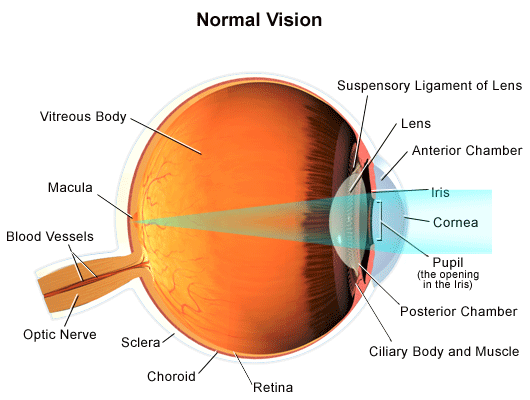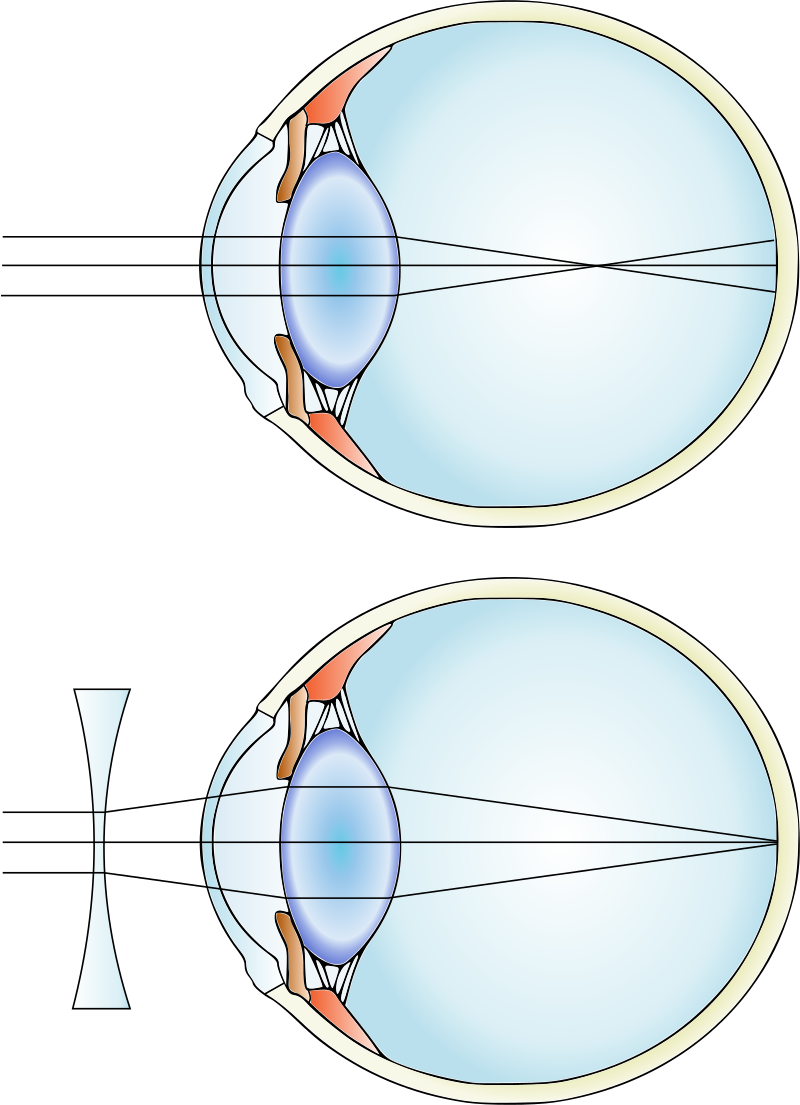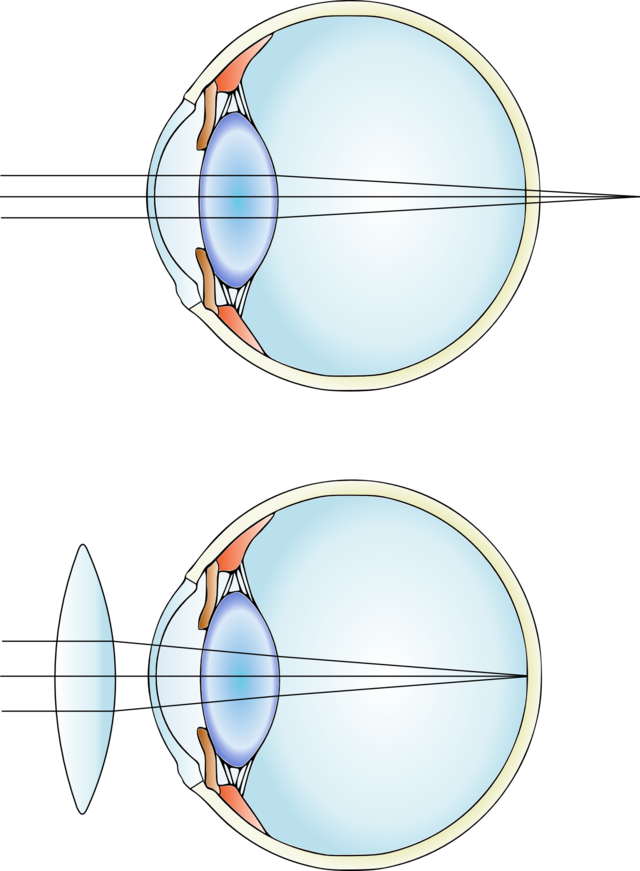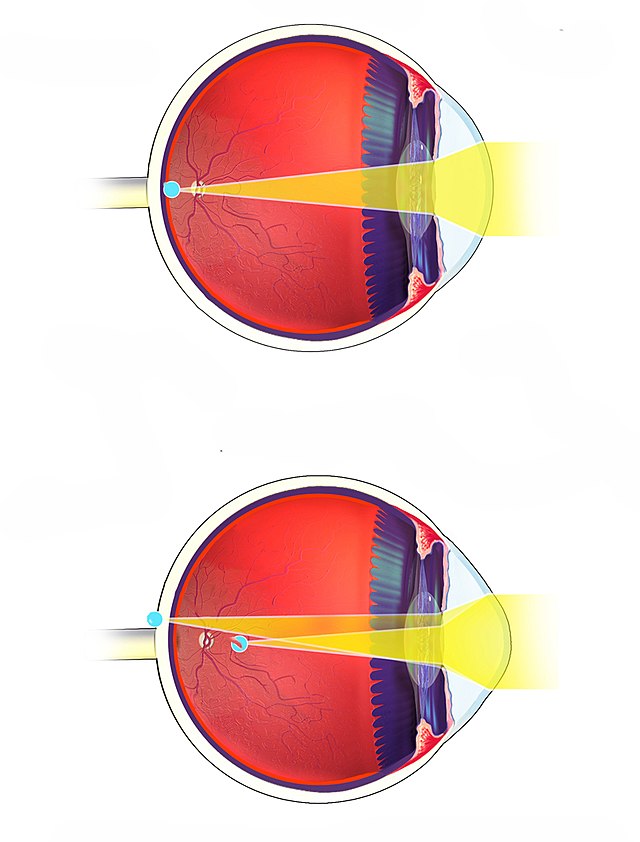Defects of vision and their correction
We are able to see due to light rays reflecting off of objects and entering the eye. The rays are refracted in stages by the different parts of the eye and come to focus on the retina. The image below helps you picture this process.

A diagram showing the formation of an image on the retina in a human eye without any defects. All of the light focuses on the retina. Standford Children’s Health
In your exam, you might see the lens shown as just a simple straight line. Also, check out our explanation on Physics of Vision for more info on how we are able to see.
The lens of the eye
The eye lens is composed of fibrous, jelly-like material. Its curvature can vary to some extent depending on the ciliary muscles. Changes in the curvature of the eye’s lens can change its focal length:
- As the ciliary muscles relax, the lens becomes thinner, which will cause the focal length to increase. This allows you to see objects in the distance clearly.
- When you look at an object near you, the ciliary muscles contract, increasing the curvature of the lens. The lens becomes thicker, and as a result, the focal length of the eye lens is shortened. This allows you to see nearby objects clearly.
Ciliary muscles are the muscles in the eye that relax and tighten to change the shape of the lens.
Accommodation is the ability of the eye lens to adjust the focal length.
Refractive defects of vision and their causes
There are three main refractive defects of vision that are all common, namely myopia or short-sightedness, hypermetropia or long-sightedness, and astigmatism.
Myopia
Myopia is also known as short-sightedness or near-sightedness. A person with myopia can see nearby objects clearly, but distant objects appear blurry.
The far point is the point furthest from the eye at which an object can be accurately focused on the retina.

Myopia and its correction with a diverging lens. I.S. Gumenyuk CC BY-SA 4.0
In a myopic eye, the image of a distant object is formed in front of the retina. This defect happens when the focusing system is too powerful, resulting in the image coming into focus before the retina. This may happen because of excessive curvature of the eye lens or elongation of the eyeball.
To correct this defect, a lens with negative power is needed to decrease the overall power of the system. This can be done using a diverging lens (see image above). The distance between the lens of the eye and the correcting lens affects the power of the system. The equation below gives the power of a lens
\[P = \frac{1}{ƒ}\]
Here, f represents the focal length of the lens measured in meters. The units of power for lenses are known as dioptres, represented by the letter D. If needed, you can find the focal length f using the lens equation:
\[\frac{1}{ƒ} = \frac{1}{u} + \frac{1}{v}\]
Here, u is the distance between the lens and the object, and v is the distance between the lens and the image. Both of these quantities are measured in meters.
Calculate the power needed to correct the vision of a short-sighted person with a far point of 2.5 metres.
Solution
Recall the following equation:
\[P = \frac{1}{ƒ}\]
The value for f is just negative of the far point distance as the image formed is on the same side as the object.
\[P = \frac{1}{ƒ} = -0.4 D\]
A lens correcting myopia always has negative power.
Hypermetropia
Hypermetropia is also known as long-sightedness or far-sightedness. A person with hypermetropia can see distant objects clearly but not nearby objects. The near point of a person with hypermetropia is further away than the near point of someone with correct vision, which is 25cm.
The near point is the point nearest to the eye at which an object can be accurately focused on the retina.

Hypermetropia and its correction with a converging lens. I.S. Gumenyuk CC BY-SA 4.0
As shown in the image above, rays from nearby objects focus on points behind the retina. This occurs because the focal length of the lens is too long or the eyeball is too small. This vision defect can be corrected using a converging lens with the appropriate power. Converging lenses provide the additional focusing power needed to focus the image at an earlier point onto the retina.
Typically, the ability of the eye to adjust decreases with age. For most people, the near point gradually moves away. They find it difficult to see nearby objects comfortably and clearly without corrective glasses. This is caused by the gradual weakening of the ciliary muscles and the lens becoming less flexible over time.
Occasionally, a person may have both myopia and hypermetropia. Such people often need bifocal lenses. A common type of bifocal lens consists of both concave and convex lenses. The upper part is a diverging lens and promotes distant vision. The lower part is a converging lens and facilitates near vision. Nowadays, it is possible to correct refractive defects with contact lenses and surgery.
Calculate the power of the lens needed to be able to correct the vision of a long-sighted person with a near point of 2.5 metres.
Solution
The near point of someone with correct vision is 0.25m, so the near point should be corrected to this value. We can use the lens equation to find the focal length:
\[\frac{1}{ƒ} = \frac{1}{u} + \frac{1}{v}\]
The value of u is 0.25m, and the value of v is -2.5m, as this is where the image is formed. This value is negative as it is on the same side of the lens as the object. Plugging the values into the equation gives f = 0.28 m.
Now we can use the equation for the power of a lens to calculate the power:
\[P = \frac{1}{ƒ} = 3.6D\]
A lens-correcting hypermetropia will always have positive power.
Astigmatism
An irregularly-shaped lens or cornea can cause light rays entering the eye to be in focus for some planes and out of focus for others (see image below). This is called astigmatism. For example, someone with this condition might have horizontal lines in focus and vertical lines out of focus. As a result, there is no single point of focus for the light rays, and these points are often not at the retina.
Astigmatism can be corrected by using a cylindrical lens that increases or decreases power in one plane so that the light rays in this plane come into focus with those from other planes. A cylindrical lens consists of curved faces that are sections of a cylinder. As a result, the radius is different at points along the surface, and parallel rays are all focused on the same point.

Diagram showing a human eye with astigmatism. BruceBlaus CC BY-SA 4.0
The prescription for a cylindrical lens consists of three pieces of information:
- The power needed, in dioptres, to correct someone’s short- or long-sightedness. This is known as the sphere (SPH) as it refers to the spherical lens effect.
- The additional power needed to correct astigmatism. This is known as the cylinder (CYL). It can be a positive or negative power depending on the degree of astigmatism. The value will be zero if there is no astigmatism.
- The angle to the horizontal of the plane perpendicular to the plane needs correcting due to astigmatism. The angle ranges from 0 to 180° and starts in the direction of three o’clock, moving anticlockwise. This is all from the view of the optician making the measurement. This is known as the axis (AXI) and represents the angle at which the lens is set with respect to a horizontal line across the eye.
Defects of Vision - Key takeaways
- Many people have vision defects, and different types of lenses can be used to correct these problems.
Myopia refers to someone with short-sightedness. It can be corrected with a diverging lens.
Hypermetropia refers to someone with long-sightedness. It can be corrected with a converging lens.
Astigmatism is when the cornea has different amounts of curvature in different planes. It can be corrected with a cylindrical lens.
ImagesNormal Vision. https://www.stanfordchildrens.org/en/topic/default?id=normal-vision-90-P02094
Vector illustration for myopia and its correction with a lens. https://commons.wikimedia.org/wiki/File:Myopia_and_lens_correction.svg
Hypermetropia lens correction. https://commons.wikimedia.org/wiki/File:Hypermetropia_color.png
Astigmatism. https://commons.wikimedia.org/wiki/File:Astigmatism.jpg











